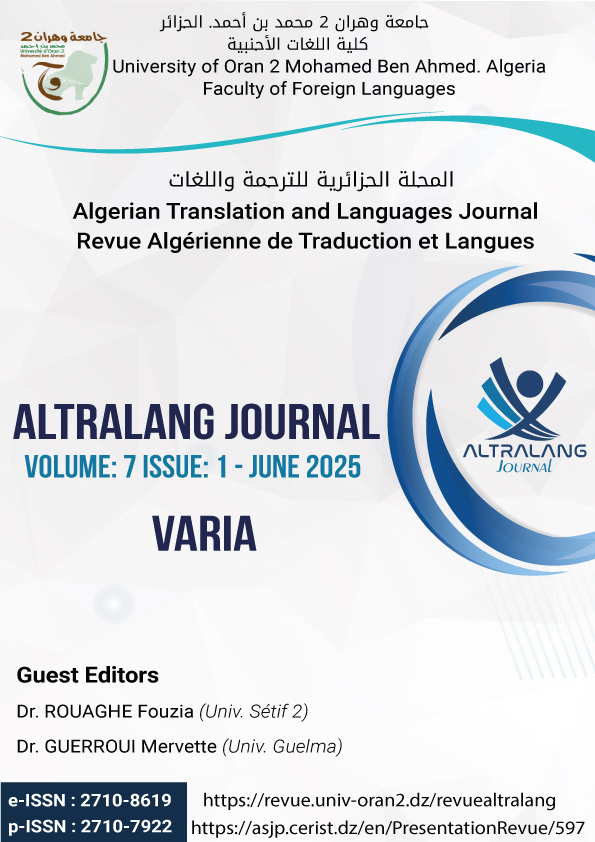Unveiling the Unheard: Acoustic vs. Perceptual Insights into the Occurrence of Intrusive Vowels in Initial Consonant Clusters of Algerian Arabic
Main Article Content
Abstract
The phonetic nature of consonant clusters is much more intricate than what a human ear may perceive. In this scope, the present research paper aims to experimentally examine biconsonantal complex onsets in Algerian Arabic to unveil the presence of subtle vocalic intervals within these clusters. To this end, both acoustic and perceptual experiments were conducted to investigate the distribution and phonetic properties of intrusive vowels. Results revealed that certain onset clusters exhibited brief, elusive vocoids that do not stem from an epenthesis process but rather serve as transitional elements to coordinate consonantal gestures. These intrusive vowels were observed to surface only in the acoustic record while maintaining audibly intact clusters. Notably, their distribution was constrained by speech rate, degree of voicing, and the sonority profile of the juxtaposed consonants. Besides, they were found to possess a phonetic quality distinct from that of the adjacent lexical vowels.
Article Details

This work is licensed under a Creative Commons Attribution 4.0 International License.
LICENSE: This work is licensed under a Creative Commons CC BY 4.0 license
References
• Boersma, P. & Weenink, D. (2022). PRAAT: Doing phonetics by computer (Version 6.0.28) [Computer program]. Retrieved from http://www.praat.org/
• Bradley, T. (2006). Spanish complex onsets and the phonetics-phonology interface. In F. Martinez Gil & S. Colina (Eds.). Optimality-Theoretic Studies in Spanish Phonology. Amsterdam: John Benjamins. pp. 15–38.
• Bradley, T. (2007). Morphological derived-environment effects in gestural coordination: A case study of Norwegian clusters. Lingua, 117. pp. 950-985.
• Carlisle, R. (2001). Syllable structure universals and second language acquisition. International Journal of English Studies, 1(1). pp.1-19.
• Clements, G. (1990). The role of the sonority cycle in core syllabification. In J. Kingston & M. Beckman (Eds.), Papers in laboratory phonology 1: Between the grammar and physics of speech. Cambridge: Cambridge University Press. pp. 283-333.
• Crouch, C., Katsika, A., Chitoran, I. (2023). Sonority sequencing and its relationship to articulatory timing in Georgian. Journal of the International Phonetic Association. pp. 1-24.
• Davidson, L. & Stone, M. (2003). Epenthesis versus gestural mistiming in consonant cluster production: An ultrasound study. In Tsujimura, M. & Garding, G. (Eds.). WCCFL22 Proceedings. Somerville, MA: Cascadilla Press.
• Davidson, L. (2006). Phonology, phonetics, or frequency: Influences on the production of non-native sequences. Journal of Phonetics, 34. pp. 104-137.
• Fougeron, C. & Ridouane, R. (2008). On the nature of schwa-like vocalic elements within some Berber clusters. 8th International Seminar on Speech Production. pp. 1-4.
• Gafos, A. (2002). A grammar of gestural coordination. Natural Language and Linguistic Theory, 20(2). pp. 269-337.
• Garmann, N.G., Simonson, H.G., Hansen, P., Holm, E. Post, B., Payne, E. (2021). Cross-linguistic variation in word-initial cluster production in adult and child language: evidence from English and Norwegian. Journal of Child Language, 48. pp. 1-30.
• Hall, N. (2003). Gestures and Segments: Vowel Intrusion as Overlap. Ph.D. Dissertation. University of Massachusetts.
• Hall, N. (2006). Cross-linguistic patterns of vowel intrusion. Phonology, 23(3). pp. 387-429.
• Hall, N. (2011). Vowel epenthesis. In Oostendorp, M.-V., Ewen, C., Hume, E. & Rice, K. (Eds.). The Blackwell Companion to Phonology. UK: John Wiley & Sons, Ltd. pp. 1576-1596.
• Levin, J. (1987). Between epenthetic and excrescent vowels (or what happens after redundancy rules). In Crowhurst, M. (Ed.). Proceedings of the West Coast Conference on Formal Linguistics. Stanford: Stanford University. pp. 187-202.
• Ridouane, R. (2008). Syllables without vowels: Phonetic and phonological evidence from Tashlhiyt Berber. Phonology. Cambridge University Press. pp. 321-359.
• Shitaw, A. (2014). An Instrumental phonetic investigation of timing relations in two-stop consonant clusters in Tripolitanian Libyan Arabic. PhD Dissertation, University of Leeds.
• Staroverov, P. (2011). Sonorant extension, transitional vowels, and gesture sharing: An acoustic study of Russian clusters. NELS 42: Proceedings of the Fourty-Second Annual Meeting of the North East Linguistic Society, University of Toronto. pp. 531-544.
• Watson, J. (2002). The phonology and morphology of Arabic. Oxford: Oxford University Press.

1.png)